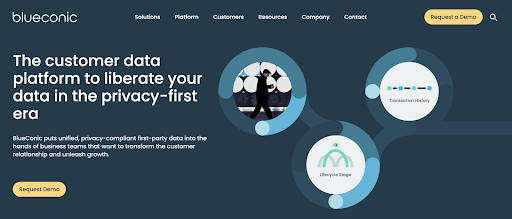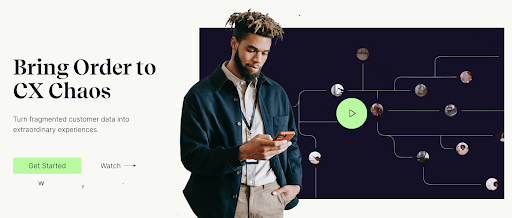I was recently talking to the founder/CEO of a startup in the health technology space. His company’s product ports electronic health records from one system to another – a major pain point for healthcare providers.
But when we spoke, he was less excited about healthcare data interoperability than about thought leadership. He had recently floated an idea that his board of directors loved: the future of connected care.
“We’re pioneering a new category,” he explained.
He excitedly showed me his home page, outreach emails, and ads focused on this concept. (Sample ad copy: “Meet the future of connected care. Today.”)
The only problem? I would bet that none of his prospects care about the future of connected care. And his category-building efforts are actively sucking the wind out of his current lead gen initiatives.
Forget “the message”
It’s an orthodoxy in enterprise B2B SaaS messaging that you need a clear, consistent, and compelling message.
This is wrong. (Or rather, it’s incomplete.)
Too many companies confuse the message that their investors love with a message that will resonate with their customers and prospects.
One of my all-time favorite pieces on this topic is this gem from Tom Tunguz on how to create tension in your marketing message. He talks about the early days of Box, when founder Aaron Levie was touting the future of collaboration (visionary!) at the same time that the website was pitching Box as an alternative to FTP (concrete).
Tom interprets this as evidence for the need for a customer segmentation strategy – with different messages for different segments. That’s a good takeaway. But I would go a step further.
Every startup with dreams of category disruption is simultaneously fighting a battle on two fronts:
- The long-term battle to become a category-defining leader. This battle is mainly focused on non-buying participants in the category (primarily investors, industry analysts, and influencers).
- The short-term battle to actually win customers. This battle is mainly focused on actual prospects with actual money, who might actually buy a thing that you have.
And every startup needs at least two core messages – one for each of these key audiences.
Use your selling message on investors or analysts and they’ll write you off as “tactical,” “a point solution,” “not strategic.” Use your thought leadership message on prospects, and their eyes will glaze over as they wonder why you’re lecturing them about the future of their industry.
A side-by-side comparison
The customer data platform (CDP) category is one of the most crowded in enterprise B2B SaaS, with 161 vendors accredited by the Customer Data Platform Institute as of July 2022.
CDPs help brands unify and analyze data that they collect on their customers (purchase records, onsite behavior, email engagement, etc.).
Let’s look at an example of two CDP websites:


Vendor A’s homepage uses a very “thought leadership-y” hook: the revolution in consumer data privacy. Limitations on cross-app and cross-site tracking, combined with regulations like GDPR and CCPA, have made it more challenging for brands to personalize the experience for their customers.
Vendor B’s message is simpler and more modest in scope: stop bugging your customers with conflicting messages and experiences as they engage with your brand. (CX stands for “customer experience.”)
Vendor A’s positioning is intriguing and strategically compelling. But in my mind Vendor B’s message is 10x more effective as a selling message. Why?
The majority of their buyers – including CMO’s – don’t care about the “privacy-first era,” at least not for its own sake. (That’s something that investors and analysts care about.) They probably don’t stay awake at night worrying about how to “liberate their data” – whatever that means.
What they do probably care about is the loss of signal from customer data. This has led to an increase in customer acquisition cost and a decline in the effectiveness of paid marketing channels: things that do keep CMOs awake at night, but that don’t make an appearance anywhere on their homepage.
Vendor B, in contrast, isn’t swinging for the fences with a thought leadership message. They’re not asserting that the world has changed and that there will be winners and losers. There’s nothing about “transforming” or “redefining” CX.
But their message is concrete and anchored in pain points that their actual personas experience today – which makes it a strong selling message.
Okay, how do I manage the tension?
It might seem like I’m minimizing the importance of thought leadership. I’m not – quite the contrary. Thought leadership lays the groundwork for owning your category, which should be a goal of every B2B tech startup.
But it’s critical to keep thought leadership logically separated from your prospect-oriented activities. Remember: “the future of connected care” isn’t going to get any healthcare prospect to click on an ad or open a cold email.
My recommendation is that startups maintain a document that lays out their core thought leadership theses – and then traces them to concrete pain points that can form the core of their “selling message” today. This would look something like:
- Secular trend (i.e., something that has changed about the world)
- What it means for the industry in 5 years
- The pain it causes today
- How your product solves that pain
TrueAccord is an example of a B2B fintech scaleup that has done this masterfully. (Shameless plug: you can read more about Blue Seedling’s work with TrueAccord here.)
If you follow CEO Ohad Samet on Twitter or listen to him on industry podcasts, he talks almost exclusively about the future of the collections industry. But TrueAccord’s website and marketing materials are focused on the concrete pain points that creditors are facing today. If they were to use the above template, my guess is that it would look something like the following:
| Secular trend (i.e., something that has changed about the world) | What it means for the industry in 5 years | The pain it causes today | How your product solves that pain |
| Changes in technology (e.g., phone screening), consumer preferences (for digital self-serve), and consumer regulatory protections | Traditional call center approaches to collections will become obsolete | Lower right party contact rate (RPRC) and reduced ability to collect | Intelligent digital-first technology that meets consumers on the channels they want to engage on |
The bottom line
Every enterprise B2B startup needs two messages: a visionary “thought leadership” message focused on investors and industry influencers, and a selling message that highlights their prospect’s current pain points in a clear and compelling way.
The most successful startups are the ones that can crisply define these two – and have the discipline to know when to use which.








